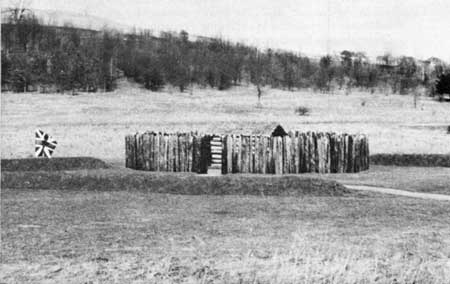MENU
|
Glimpses of Historical Areas East of the Mississippi River |
|
The Colonial Period |
|
PENNSYLVANIA |
Special Feature: Scene of a battle between colonial troops led by George Washington and French troops assisted by Indians, July 3, 1754.

Great Meadows and Fort Necessity.
FORT NECESSITY National Battlefield Site, Fayette County, Pa., is of unique interest as it marks the place of George Washington's entrance into the public eye as a soldier. In 1931, in connection with the approaching George Washington Bi-Centennial Celebration, the site received recognition as being of national importance, and a fort was erected there m commemoration of that earlier post where fighting began in the French and Indian War.
With a force of 159 Virginians, Washington, then but 22 years old, set out in the spring of 1754 on an expedition against the French forts in western Pennsylvania, claimed at that time by Virginia. The little army moved slowly westward from Alexandria through the wilderness. Two months later Washington and his men reached Great Meadows, 11 miles east of the present city of Uniontown, Pa., and threw up entrenchments, the beginning of Fort Necessity. There he received reenforcements which increased his command to about 300 men.
Some 6 weeks of skirmishing and scouting followed, during which intermittent rains, low supplies, and a lack of expected reenforcements from New York and North Carolina combined to put the ability and leadership of the youthful officer to a severe test. On the morning of July 3 a force of some 900 French and Indians attacked the colonists, driving in the advance post and keeping up an incessant fire throughout the day. Washington's men replied with spirit and could not be driven from their position despite the vastly superior number of the enemy and the fact that the attacking troops were sheltered by trees. After darkness fell, a parley was held and it was decided that both forces should retire from the field with all the honors of war. On July 4, 1754, Washington marched out at the head of his troops, drums beating and colors flying; the French marched off in the opposite direction. Thus began the French and Indian War, which was not to close until 1763, when the French were ejected entirely from the North American Continent.
 Top
Top
Last Modified: Thurs, Nov 23 2000 10:00:00 pm PDT
http://www.cr.nps.gov/history/online_books/glimpses3/glimpses1e.htm
![]()
